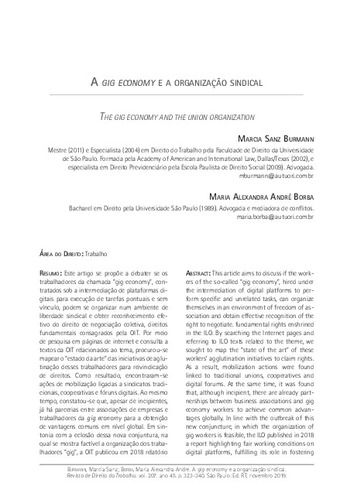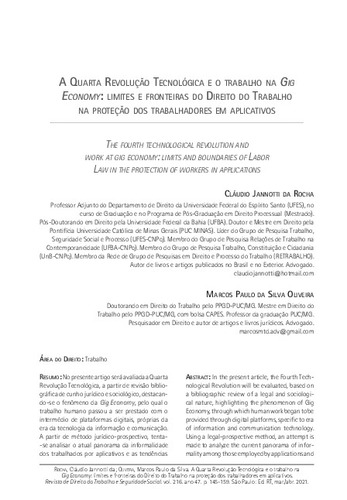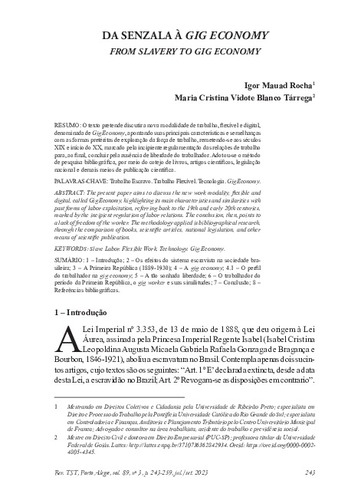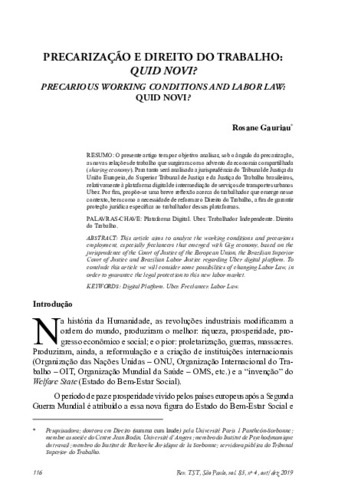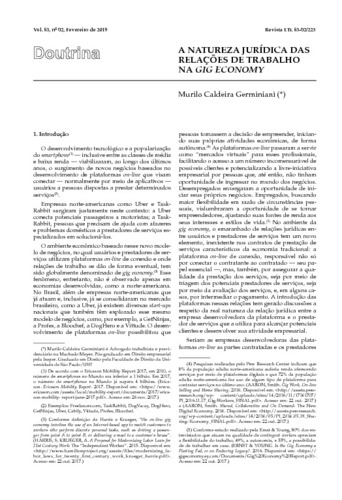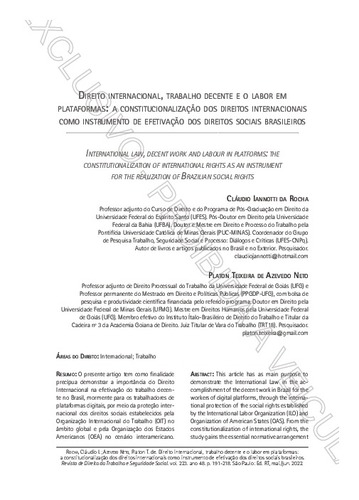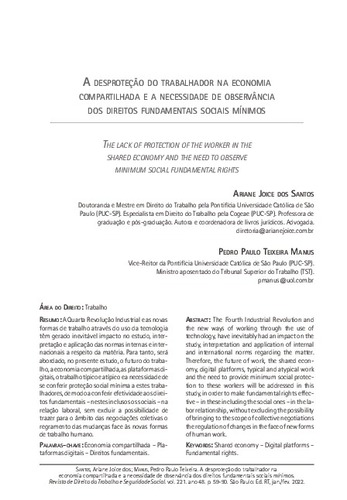Artigo de periódico
A gig economy e a organização sindical
| dc.contributor.author | Burmann, Marcia Sanz | |
| dc.contributor.author | Borba, Maria Alexandra André | |
| dc.date.accessioned | 2020-02-04T21:29:11Z | |
| dc.date.available | 2020-02-04T21:29:11Z | |
| dc.date.issued | 2019-11 | |
| dc.identifier.citation | BURMANN, Marcia Sanz; BORBA, Maria Alexandra André. A gig economy e a organização sindical = The gig economy and the union organization. Revista de direito do trabalho, São Paulo, v. 45, n. 207, p. 323-340, nov. 2019. | pt_BR |
| dc.identifier.uri | https://hdl.handle.net/20.500.12178/167701 | |
| dc.description.abstract | [por] Debate se os trabalhadores da chamada "gig economy", contratados sob a intermediação de plataformas digitais para execução de tarefas pontuais e sem vínculo, podem se organizar num ambiente de liberdade sindical e obter reconhecimento efetivo do direito de negociação coletiva, direitos fundamentais consagrados pela OIT. Por meio de pesquisa em páginas de internet e consulta a textos da OIT relacionados ao tema, procurou-se mapear o "estado da arte" das iniciativas de aglutinação desses trabalhadores para reivindicação de direitos. Como resultado, encontraram-se ações de mobilização ligadas a sindicatos tradicionais, cooperativas e fóruns digitais. Ao mesmo tempo, constatou-se que, apesar de incipientes, já há parcerias entre associações de empresas e trabalhadores da gig economy para a obtenção de vantagens comuns em nível global. Em sintonia com a eclosão dessa nova conjuntura, na qual se mostra factível a organização dos trabalhadores "gig", a OIT publicou em 2018 relatório em que destaca condições justas de trabalho nas plataformas digitais, cumprindo seu papel de fomentar a regulação de iniciativas que propiciem o exercício da liberdade sindical e do direito de negociação coletiva no âmbito da gig economy, o que provavelmente culminará, em futuro próximo, numa convenção específica sobre o tema. | pt_BR |
| dc.description.abstract | [eng] This article aims to discuss if the workers of the so-called "gig economy", hired under the intermediation of digital platforms to perform specific and unrelated tasks, can organize themselves in an environment of freedom of association and obtain effective recognition of the right to negotiate. fundamental rights enshrined in the ILO. By searching the Internet pages and referring to ILO texts related to the theme, we sought to map the "state of the art" of these workers’ agglutination initiatives to claim rights. As a result, mobilization actions were found linked to traditional unions, cooperatives and digital forums. At the same time, it was found that, although incipient, there are already partnerships between business associations and gig economy workers to achieve common advantages globally. In line with the outbreak of this new conjuncture, in which the organization of gig workers is feasible, the ILO published in 2018 a report highlighting fair working conditions on digital platforms, fulfilling its role in fostering the regulation of initiatives that promote the exercise of freedom of association and the right to collective bargaining under the gig economy, which will probably culminate in the near future in a specific convention on the subject. | pt_BR |
| dc.description.tableofcontents | Gig economy: o que é? -- A OIT e a gig economy: Exemplos de iniciativas de aglutinação e reivindicação de direitos de trabalhadores da gig economy -- Posicionamento das empresas diante do crescimento da gig economy -- Iniciativas para uma gig economy mais justa -- A importância da organização sindical na gig economy | pt_BR |
| dc.language.iso | pt_BR | pt_BR |
| dc.relation.ispartof | Revista de direito do trabalho: vol. 45, n. 207 (nov. 2019) | pt_BR |
| dc.subject | Organização Internacional do Trabalho (OIT) | pt_BR |
| dc.subject | Relação de trabalho | pt_BR |
| dc.subject | Aplicativo de tecnologia | pt_BR |
| dc.subject | Trabalhador autônomo, aplicação de computador | pt_BR |
| dc.subject | Sindicato | pt_BR |
| dc.subject | Negociação coletiva de trabalho | pt_BR |
| dc.title | A gig economy e a organização sindical | pt_BR |
| dc.title.alternative | The gig economy and the union organization | pt_BR |
| dc.type.genre | Artigo de periódico | pt_BR |
| dc.identifier.rvbisys | 001163108 | |
| dc.relation.ispartoflink | https://hdl.handle.net/20.500.12178/167591 | pt_BR |
Coleção
-
Artigos9566


